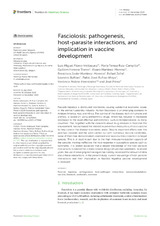Fasciolosis: pathogenesis, host-parasite interactions, and implication in vaccine development
Autor
Flores Velazquez, Luis Miguel
Ruiz-Campillo, María Teresa
Herrera-Torres, Guillem
Martínez Moreno, Álvaro
Martínez-Moreno, Francisco Javier
Zafra, Rafael
Buffoni Perazzo, Leandro
Rufino-Moya, Pablo José
Molina-Hernández, Verónica
Pérez, José
Editor
FrontiersFecha
2023Materia
Fasciola hepaticaPathogenesis
Host-pathogen interaction
Immunomodulation
Vaccine
Livestock
Onehealth
Zoonosis
METS:
Mostrar el registro METSPREMIS:
Mostrar el registro PREMISMetadatos
Mostrar el registro completo del ítemResumen
Fasciola hepatica has a worldwide distribution causing important economic losses in animal production industry. Human fasciolosis is considered an emerging zoonosis in areas of Andean America, Asia, and Africa. The control of the disease both in humans and animals is based in the use of anthelmintic drugs which has induced increased resistance to most effective anthelmintics such as triclabendazole in many countries. This together with the concerns of drugs residues on food and environment has increased the interest for preventive measures such as a vaccine to help controlling the disease in endemic areas. Despite important efforts during the last two decades and the work carried out with numerous vaccine candidates, none of them has demonstrated consistent and reproducible protection in target species. This is at least in part due to the high immunomodulation capacity of the parasite making ineffective the host response in susceptible species such as ruminants. It is widely accepted that a deeper knowledge of the host-parasite interactions is needed for a more rationale design of vaccine candidates. In recent years the use of emerging technologies has notably increased the amount of data about these interactions. In the present revision current knowledge of host parasite-interactions and their implication in Fasciola hepatica vaccine development is reviewed.

